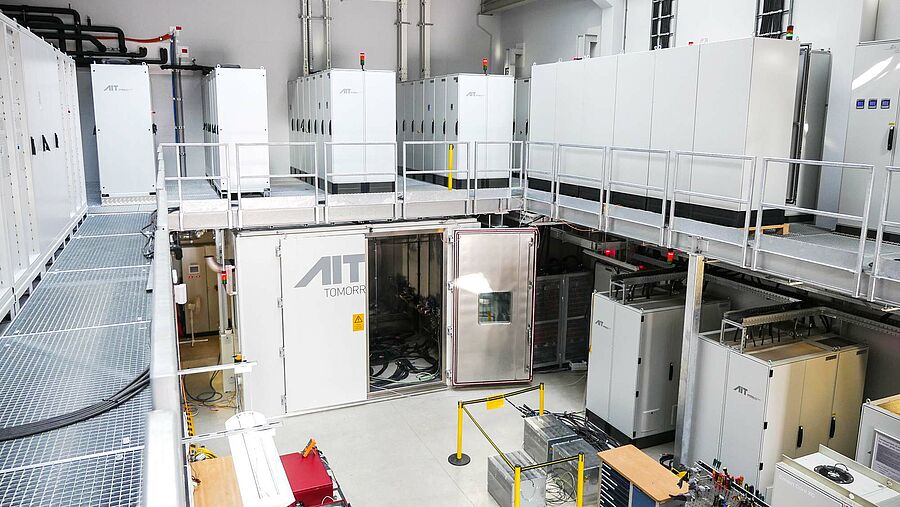GRID-CONNECTED INVERTERS
Grid-connected inverters play a pivotal role in decentralized energy generation. They are the key element for integrating renewable energy into our power grids. As a central component of photovoltaic or wind power systems, they serve as the interface to convert direct current (DC) into alternating current (AC) and feed it into the public power grid.
AIT is a pioneer in the research, development, and testing of innovative functionalities for grid-connected inverters, enabling a high share of decentralized renewable energy to be integrated into the power grid.
DEVELOPMENT OF GRID-CONNECTED INVERTERS
AIT offers comprehensive services for the development of grid-connected inverters, including:
- Licensable technologies
- Development services in hardware and software
- Development platforms for controller design
- Comprehensive laboratory infrastructure for development and acceptance testing of grid-connected inverters.
Wide Bandgap Semiconductors in Grid-Connected Inverters
Wide bandgap semiconductors represent an innovative alternative to conventional power electronics based on silicon technology for grid-connected inverters. Integrating wide bandgap semiconductor solutions typically enhances inverter efficiency and reduces volume. Commonly available components are based on materials such as silicon carbide (SiC) or gallium nitride (GaN), which, compared to traditional silicon-based inverters, offer higher switching frequencies and greater thermal resilience.
At AIT, experts focus on the optimal integration of these components into the power electronics ecosystem, from semiconductors to filter technology.
Grid Forming / Dynamic Control of Grid-Connected Inverters
The shift in the energy mix toward renewable energy sources and the increasing decentralization of power generation pose significant challenges to grid stability. To minimize stability issues and enhance the robustness of energy systems, grid control strategies have been developed to mimic the behavior of synchronous generators and improve the emulation of inertia in renewable energy generation systems. Grid-forming inverters play a crucial role in this context, and our research focuses on the development, testing, and validation of advanced grid-forming control strategies for evolving power grids.
VALIDATION OF SPECIFIED FUNCTIONS
A prerequisite for connection to public power grids is the verification and confirmation that these inverters meet the required standards, norms, and specifications.
The validation process covers various aspects:
- Technical Specifications:
The technical characteristics of the grid-tied inverter must meet defined requirements, including factors such as power factor, efficiency, voltage and frequency regulation, and response to grid fluctuations. - Grid Connection Regulations:
Compliance with national and international grid connection regulations is essential. This ensures the inverter synchronizes correctly with the public power grid and does not cause disruptions. - Safety Standards:
Validation also involves verifying safety standards. This includes ensuring the safe operation of the inverter as well as the protection of people and property. - EMC Testing:
Electromagnetic compatibility testing ensures that the inverter does not generate disruptive electromagnetic emissions and is robust against external influences. - Stability and Reliability:
The validation process includes tests for the stability and reliability of the grid-tied inverter under various operating conditions. Long-term tests are also conducted to ensure sustained performance over time. - Testing Standards:
International testing standards such as IEC, UL, or other relevant norms are incorporated into the validation process. Collaboration with certification bodies and adherence to these standards streamline the validation process.
Validation is an iterative process carried out during both the development phase and series production. It ensures that grid-tied inverters meet the highest quality and performance standards and can be seamlessly integrated into existing power grids.
GRID INTEROPERABILITY AND COMMUNICATION
Comprehensive testing is conducted in the area of grid interoperability to ensure that all components can seamlessly interact. This includes end-to-end functionality testing from the communication interface to the power interface, based on SunSpec specifications. Integration tests with third-party external devices, such as sensors, PV systems, and grid operator gateways, ensure the smooth collaboration of various systems. Additionally, Controller Hardware-in-the-Loop (CHIL) tests are performed to evaluate the performance and adaptability of converter controls.
Our Service Portfolio:
- Interoperability Testing
- End-to-End Functionality Tests from the communication interface to the power interface
- Integration Tests with third-party external devices
- Controller Hardware-in-the-Loop (CHIL) Tests
GRID CODE CONSULTING AND MODELING
The focus of grid code consulting lies in expertise on global grid connection requirements. This includes not only the specific regulations of individual regions but also comprehensive advice on globally applicable standards. The development and implementation of numerical simulation models in Matlab/Simulink/SimPowerSystems®, PLECS, and DIgSILENT Powerfactory® enable precise modeling and simulation of grid connections. Computer simulation-based studies are conducted to optimize smart grid applications and prepare them for future challenges.
Our Service Portfolio:
- Consulting on Global Grid Connection Requirements
- Development and Implementation of Numerical Simulation Models in Matlab/Simulink/SimPowerSystems®, PLECS, and DIgSILENT Powerfactory®
- Computer Simulation-Based Studies for Smart Grid Applications
SOFTWARE AND FIRMWARE DEVELOPMENT FOR INVERTERS
Application of current software standards and development methods
- Design of high-level software architecture
- Development of RTOS-compliant DSP/uC firmware and FPGA-HDL code
- Creation of portable application software
Standards & Regulatory Frameworks for Inverters – International & within the EU
Compliance with national and international grid connection rules is crucial for the integration of on-grid inverters into power grids. Various standards and regulations outline the requirements for safe and efficient operation.
EN 50549-1/2/10 defines the requirements for generation plants connected in parallel to distribution networks. In Germany, key grid connection regulations include VDE AR N 4105, VDE 0124-100, VDE AR N 4110, FGW TR3, and VDE 0126-1-1, while Austria follows OVE R 25.
IEC 62116 is an international standard for grid-connected photovoltaic inverters, specifying test procedures to prevent unintentional islanding. International testing standards such as IEC, UL 1741, and IEEE 1547.1 are available through partnerships with global certification providers.
In addition to connection standards, EMC testing, immunity testing, safety testing, and fault analysis of key components in power conversion systems are essential. These tests ensure not only compliance with legal regulations but also the robustness and reliability of on-grid inverters in various operating scenarios.
Adherence to these standards and regulations is critical to ensuring the safe and efficient integration of on-grid inverters into national and international power grids.
Compliance Testing for National and International Grid Connection Rules
Our Service Portfolio:
- EN 50549-1/2/10
- VDE AR N 4105, VDE 0124-100 (Germany)
- VDE AR N 4110, FGW TR3 (Germany)
- VDE 0126-1-1 (Germany)
- OVE R 25 (Austria)
- IEC 62116
- International testing standards (IEC, UL 1741, IEEE 1547.1, etc.) through partnerships with global certification providers.
- EMC testing, immunity testing, safety testing, and fault analysis of critical components in power conversion systems.







